Quick Cooking but With the Soul
an unmeasured recipe from my Khala Jaan and a recipe for my Chanaa Aloo
It’s getting late, and I’m scrambling to get this Substack issue out.
Oh, hello and welcome to the Empress Market substack newsletter! It has now been 4 months of writing and I am coaxing myself to enter a new season of writing. February didn’t present itself as a busy month until work kicked in, catering wedding tastings, hosting the I ♥️LHR supperclub, and a work trip to Koln – and hours fell through my fingers like water.
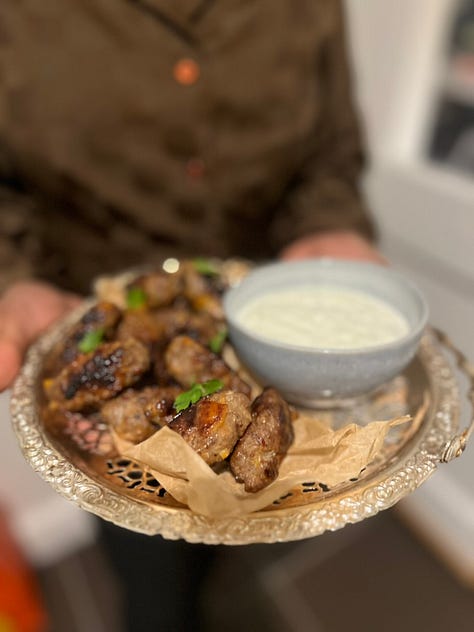

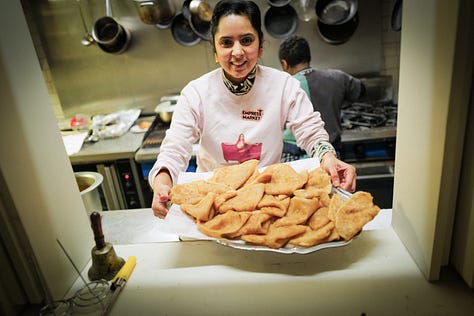
I write this monthly newsletter to capture thoughts about my desi culture, to put words on the food I eat and love. Yes, yes, all of that but also I write to meet the deadlines I set for myself.
As the days pass and the month nears end, I often toy with the idea of skipping an issue. Who is even reading this newsletter, other than my mum and husband? I ask myself. There are so many better writers out there, I convince myself. Who needs to hear my voice? Words of self doubt play a vital role in my procrastination when I’m inches, nay, millimeters (I know I have changed metrics but then again who is reading) away from Delivery Day. I write to Margaux, my writing mentor (Margaux I love you for your patience), sandwiching the words ‘sorry I’m late’ between friendly pleasantries. I promise her a draft by the end of the weekend. It is now Sunday 7pm. I panic. But I am writing.
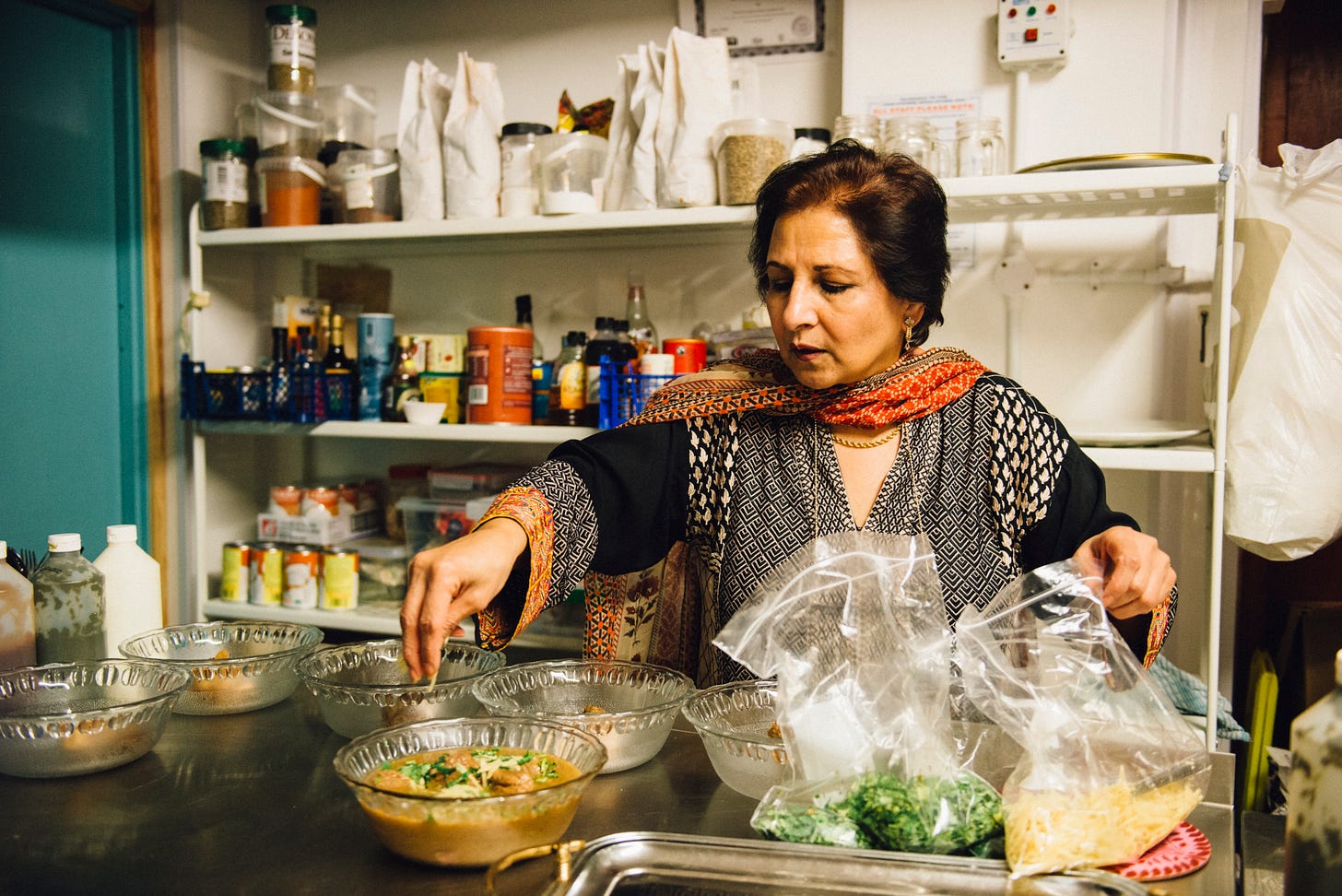
The sense of urgency that comes from the frantic rummaging through the store cupboard of ideas isn’t a new feeling. It reminds me of the weekday meals my mum or my aunts would cook when I was growing up. These women of the 80s/90s were made to believe they could have it all. They could be the breadwinner and the homemaker. They built careers, working full time as teachers, marketers, entrepreneurs, also bought up broods of children and managed domestic responsibilities all at once. The Working Girl/Martha Stewart fantasies encouraged them to aspire, they could do it all. And, if my mum and her sisters ever felt it was too much, there was something wrong with them and not the system.
As I type this, I am trying to find a picture of Martha Stewart or Melanie Grifith having it all, but I feel Dick Van Dyke as the one man band in Mary Poppins better encapsulates the mood of the era.
Rather than something they thought they could achieve and do to themselves, this way of life was just thrust upon the power suit by day and ruffled pinny by night cohort of women. This was not a choice. Life is a graft. They had to work 9 to 5 to pay the bills and still get the dinner on the table.
I remember these meals.
Cooked under literal pressure, the daals and ghosht that can take up to an hour to tenderise under an open flame, were ready in mere minutes in the sealed metal contraption, all with a whistle and a hiss. And what to serve on the side - Mum scooped out one cup of rice, enough for four, gave it a quick wash, brought it to a boil, 10 minutes to simmer, and another 10 minutes to sit in its own steam. Done. Or maybe she would be serving rotis. There might be some raw, kneaded dough in the fridge, stowed away in a reclaimed plastic butter or yoghurt tub from the night before. If not, mum poured some cold water over flour, followed by a generous pinch of salt to form a swift dough. She gave it a good mukki and drew six round perras. She’d bring the tub of aatta, bailan and tawa out from the special kitchen cabinet - the oven - and the rotis were made in a flash. To me, the speed at which she would roll out the most perfect round rotis, toss them on the tawa and sear them into a puff on the open flame was the image of the frenetic energy by which whole meals came together back then. Thinly sliced red onions were tossed in some vinegar or the juice of half a lemon, offered as a fresh salad. The lid of achar popped open.

This was dinner at its finest. Quick cooking with soul. The soul of my mama and the contents of the dry store laid bare on the table.
The ‘classic/traditional/authentic’ desi home cooks do not have time to flick through cookbooks, call up their own mothers for recipes or doom scroll through tiktok for kitchen hacks.
They perfected their craft out of sheer necessity - the food needs to get on the table.
The recipes for some of the most quintessential Pakistani home cooked meals are skeletal. A handful of ingredients, if not less, brought together to conjure the most wholesome meals. The instructions are also sparse, so simple they can be summarised in a single but long Proust-esque sentence. Just now, with this newsletter, I have shared two such recipes, if you were paying attention. The craft lies not necessarily in the quality of fresh produce – these meals are dry store staples after all – it relies on the home cook’s alchemy with cooking.
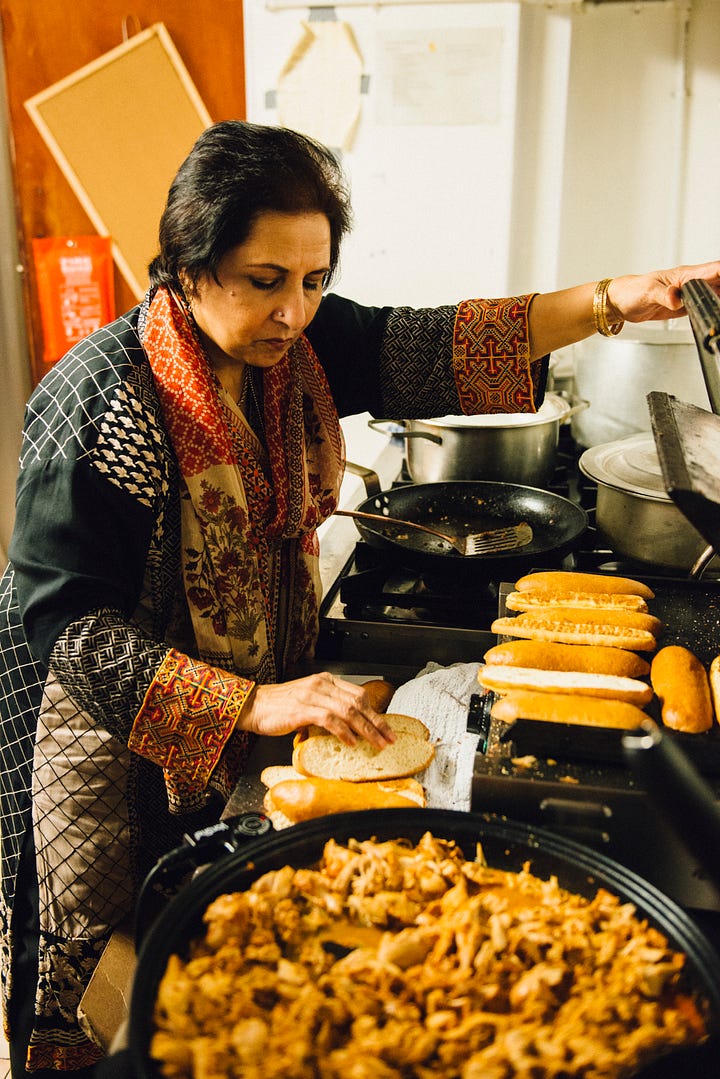

When they cook, desi women conjure the smells and sounds of their home, the sizzling onions, the tempering spices, the steam that wafts from a pateeli as the lid is finally lifted. The art lies in knowing when to switch between the various stages, once you have reached bhunnai, not giving enough time and the spices are raw, the onion too firm, and to go too far and the whole thing is burnt, the base of your cooking rancid.
This was a culinary school with classes taught from memory and practice. Stages not in restaurant kitchens but at home, night after night, rinse and repeat, rinse and repeat.
Countless ruined meals were also served along the way. And I remember those too. The job was not easy. Rushing home to cook dinner was not always a joy. Years later, I can still feel the awkward silences during those family meals. Childhood memories of mum’s tear stained cheeks when the stress was too much. The stress revealed itself in the overcooked daal or the smell of burnt rice that had caught at the base of the pan. I try to focus on the fonder childhood meals and it pinches my heart when all my mum remembers is the stress but, still to this day, she carries on cooking.
And that is the way: the show must go on and dinner is always served. Not all desi cooking is romantic, at least for the cook. For the desi working mum, it’s an expression of an instinct to get the job done. It is an act of survival, passed down through generations, not as an art or a craft us the third generation cheffy types are trying to sell, but as the way to stay alive. In these perpetual troubling times, this is how my culture stays alive also. I suppose there is something romantic about that.
A few weeks ago, my eldest maternal aunt, Khala Jaan, invited my family and I over for dinner. At the golden age of 67, she single handedly cooked seven dishes to a table of eight people. I am in awe of her. How she managed to prepare everything herself, each dish with such depth of flavour, seasoned and spiced, piping hot as it reached the dinner table. One of her stand out dishes was her Chanaa Aloo, a slow cooked chickpea and potato stew. I asked her for the recipe as I ate and she flippantly replied, “there is no recipe for this dish. I make it up as I go along.” At the time, I brushed her comment off as humility. I still added it to my I♥️LHR supperclub, thinking that I would follow up with my Khala and ask again for the recipe later. Days before the event, I messaged Khala Jaan. This was her reply -


“Why is she gatekeeping her secret recipe? Why didn’t she want to pass it on to me to cook?” I complained to my mum in a sulk. She dismissed me just as my Khala had. “No one has a recipe for Chanaa Aloo, Numra. You make a tomato masala and add garam masala at the end.”
My mum’s response reminded me of the time her friend, Fahmida aunty, asked for my Palak Daal recipe. Fahmida aunty had eaten at a wedding for which I catered, and she sang high praise of my cooking. The next day, she asked my mum for the recipe for my daal.
I was offended. Nothing special!
With age and experience (in the kitchen), I appreciate what she meant now. I am less offended (in fact, I am working on caring less and less about what people say about me!). Instead, I am taking the comment as a testament to my family of homecooks who can prepare the most complicated dish at a moment’s notice. These cooks do not see what the big deal is about. They have spent a lifetime rushing around the kitchen. They get the job done. Because that is what they are supposed to do. The food will taste good because they trust the process.
Four months into writing my Empress Market newsletter, I too must tap into my desi instinct by doing the work and worry about the rest later. I’ve refrained myself from carrying out additional research for this issue and, like my family cooking, I wrote it as it flows from my fingertips. The process can be stressful and, at times, tear inducing, but I keep faith in the process, so the Alchemy may come. Hopefully, I will tap into the writing instinct. For now, I write. And I write about food.
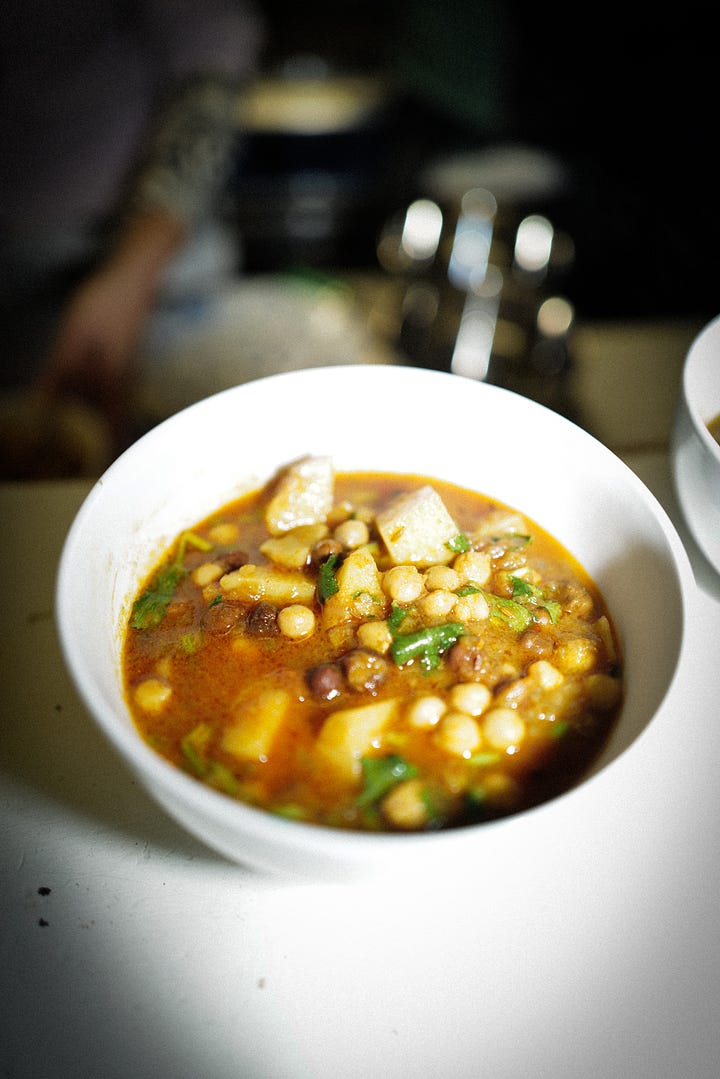

Here is my recipe for Chanaa Aloo, as I served it at the I<3 LHR supperclub. Two days before the supperclub, I had a little panic (attack) about all the cooking that needed to be done. The menu was quite ambitious and vast for one person to achieve across two evenings, after a full days’ of work. But after a little cry, I put on my headphones, dragged my granny trolley to VB and Sons for the groceries, and I just got on with it. I resisted the urge to do my research and google an online recipe; I tapped into instinct and cooked. I didn’t write a recipe down at the time, but this is what I remember. I’ve tried to give more detail than what my Khala would give, making it a bit easier for you, after all, this is what you came here for.
And, mum (thanks for reading!), if I got any of it wrong, you can leave your notes in the comments section.
Chanaa Aloo
This recipe is a fast one, it should take 30 minutes at best. I often make the onion tomato masala in a large batch on a Sunday morning, portion it into four and freeze the masala boxes. I pull out a box when I’m having one of those days and need a meal super quick, and this is one of the ways I cook it into a Pakistani saalan.
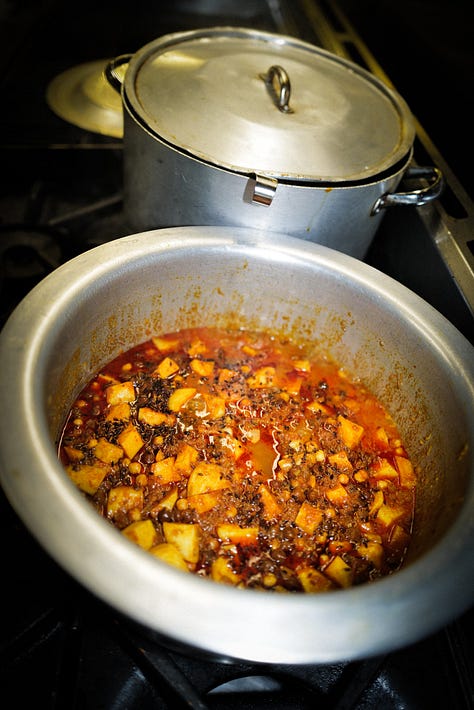

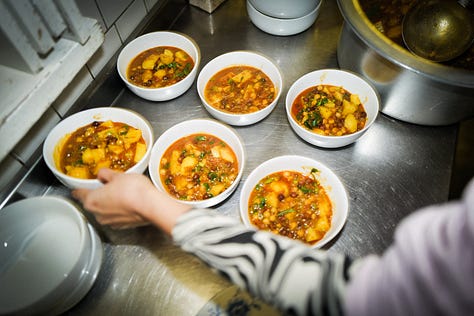
¼ cup vegetable oil
3 red onions, finely diced
1 ½ tsp salt
1 ½ tsp red chilli powder
1 tsp cumin powder
½ tsp turmeric powder
4 garlic cloves, crushed
2 inches crushed ginger [or six 2-inch blocks of frozen garlic and ginger paste as I had done]
6 tomatoes on the vine, diced [or two tins of good quality plum tomatoes. If you’re cooking in the depth of winter like I am, tinned tomatoes that were ripened in the Italian summer sun are going to taste a whole lot better than the pasty polly tunnel toms in the supermarket. My point is, using the tinned stuff is not a cheat, it’s a blessing]
1 medium sized potato, peeled and chopped into 1-inch chunks
1 tin black chanaa, drained and rinsed
1 tin white chanaa, drained and rinsed
1 ½ tsp garam masala
1 ½ tsp cumin seeds
1 ½ tsp coriander seeds
Handful of fresh coriander, stems and all, roughly chopped
Saute the red onions with the salt, over a medium heat and in the oil, until they begin to brown. This should take 10-15ish minutes.
Add the dry spices - cumin, red chilli, turmeric and cumin seed powders. Stir and cook until you can no longer smell the raw turmeric and the oil begins to separate from the onion spice masala. This is Bhunnai.
Add the garlic and ginger. You can add the frozen blocks, if you are using this fantastic kitchen convenience.
Continue to stir until you can no longer smell the raw garlic. Bhunnai.
Add the diced tomatoes and cook until the masala is reduced, the tomato water has evaporated and the oil is beginning to separate, the masala coming away from the edge of the pan. Bhunnai.
Add the peeled and chopped potato with a splash of water. Put the lid on the simmering pan and let the potatoes cook in the masala for, I would say 5 minutes?
Add the tin of black chickpeas and put the lid back on the pan. Give it 3 or so minutes.
Toast the cumin and coriander seeds. Be careful not to burn them, you just want to give the seeds a little colour and draw out the natural oils for their flavour.
Lightly crush the seeds with the help of a pestle and mortar. Set aside for now.
Add the white chickpeas followed by the garam masala.
Check for seasoning.
Sprinkle the seeds and fresh coriander and stir through the Chanaa Aloo just before serving.
Best eaten with a fresh roti or fried puri, if you can be bothered to make one! A frozen paratha is a pretty decent alternative.
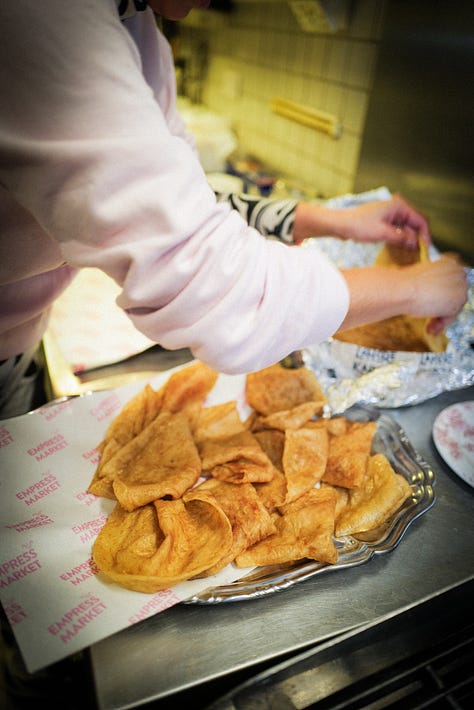

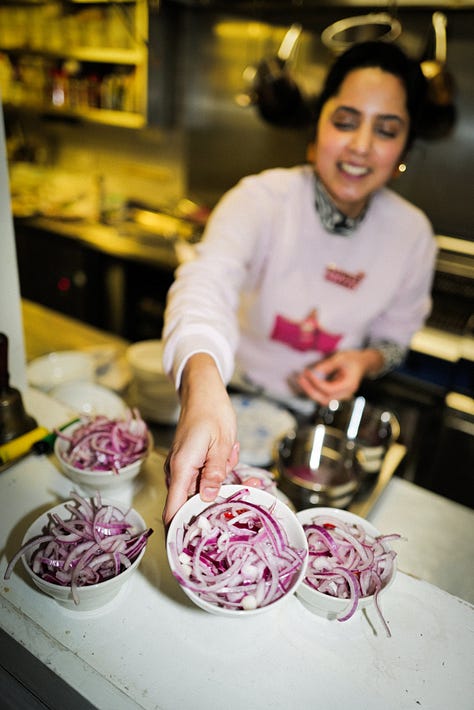
Stay tuned for my Suji ka Halwa recipe popping into your inbox in March. This semolina pudding is quick to throw together if your craving leads you down that path, or if those unexpected guests turn up and you need to whip something up pronto!
Numra x
If you enjoy this newsletter, feel free to share it with friends.
PS. head to my website for more recipes and to learn more about my catering and supper clubs.








Flashbacks of me asking my mother for a recipe then after 5 long voice notes from her just looking for an online recipe because what I got was like building IKEA furniture with the instructions 😅
I really enjoy your newsletter. The recipes are inspiring. Your joy of sharing your food shines through.